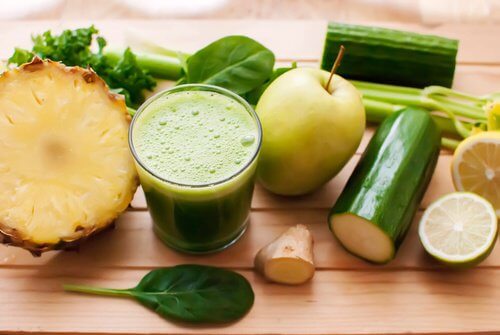Artery Cleansing Juices and Teas

Your arteries get clogged after you reach a certain age thanks to a host of bad habits, like eating unhealthy fats, being overweight, and more. Here we will suggest a few artery cleansing juices and teas.
In today’s article, we also want to explain why this happens and what the consequences of clogged arteries can be.
Why do arteries become clogged?
Over the years, your arteries tend to accumulate fat from the body where it builds up. Thus, forming a coating of plaque along the inner walls and causing them to lose their elasticity.
There are certain factors that influence the onset of this serious health problem:
- Smoking
- Having high cholesterol and triglyceride levels
- High blood pressure
- Leading a sedentary lifestyle
- Being obese
- Having diabetes
- High stress
- Eating foods with large quantities of saturated fats and cholesterol
- Heredity
You might also like:
7 foods that protect against diabetes
Serious health risks
Clogged arteries are a health problem that develops gradually, but can have very serious consequences. They keep sufficient blood and oxygen from reaching your heart, eventually causing angina or a heart attack.
That’s why it’s important to avoid the risk factors and get used to regularly drinking any of the following medicinal juices and teas that will help cleanse your arteries naturally.
White Hawthorn in artery cleansing juices and teas
This herb has been used for centuries to protect the heart and arteries. Thanks to its high content of flavonoids, minerals, dopamine, and more, white hawthorn helps dilate your coronary arteries and improve overall circulation.
Thus, it’s often recommended for the treatment of tachycardia, arrhythmia, migraines, and high blood pressure.
It is also a mild sedative that helps calm the nervous system and fight insomnia.
Drink this herb as a tea.
Chamomile
Chamomile is one of the world’s most popular teas, it’s known for its ability to soothe the nervous system and improve digestion. However, we should also mention its ability to dilate the arteries and fight inflammation, which improves circulation and blood flow. Make sure to include this plant in your artery cleansing juices and teas.
Thereby, making chamomile great ingredient to help reduce high blood pressure.
Celery
Celery is rich in vitamins A, C, and E, as well as minerals such as zinc and selenium, which help improve the health of your blood. It also contains phthalide, a compound that relaxes the muscles surrounding your arteries, promoting vasodilation and better blood flow.
Celery is also one of the best foods for detox because it promotes the removal of toxins and excess fluids, and even has laxative properties. Additionally, its juice has a delicious flavor, and it also goes well with fruits like apple, pear, and pineapple.
We recommend choosing the most tender green stalks, preferably organic.
Pear
This sweet and refreshing flavor of this fruit conceals the fact that it is also excellent for your arteries. Pear helps regulate blood pressure, the high content of potassium dilates the arteries and blood vessels, it prevents blood clots from forming and improves your overall cardiovascular system.
As a sweet fruit that also contains a lot of water, pears are a great option for adding to juices because you don’t need to use extra sweetener.
If you buy organic pears, that’s even better, because the skin of the pear is also rich in beneficial nutrients.
We recommend you read:
Pineapple
Pineapple works in a way that’s similar to pears because it’s rich in potassium and helps control blood pressure. Additionally, pineapple is a tropical fruit that’s useful in the fight against obesity, helping promote gradual weight loss.
You can eat pineapple on its own. However, drinking pineapple juice lets you absorb its benefits throughout the day.
Pineapple juice you buy in the store is usually sweeter than what you can make at home, but you can try to choose ripe fruit. You can even use the pineapple rind to prepare other beverages that combat various health problems.
All cited sources were thoroughly reviewed by our team to ensure their quality, reliability, currency, and validity. The bibliography of this article was considered reliable and of academic or scientific accuracy.
- Ascaso, Juan F., et al. “Hipercolesterolemia familiar homocigota: adaptación a España del documento de posición del grupo de consenso sobre hipercolesterolemia familiar de la Sociedad Europea de Arteriosclerosis. Documento de Consenso de la Sociedad Española de Arteriosclerosis (SEA) y la Fundación Hipercolesterolemia Familiar (FHF).” Clínica e Investigación en Arteriosclerosis 27.2 (2015): 80-96.
- Lahoz, Carlos, et al. “Control del colesterol-LDL en pacientes con dislipidemias genéticas seguidos en unidades de lípidos y riesgo vascular de la Sociedad Española de Arteriosclerosis.” Clínica e Investigación en Arteriosclerosis 27.1 (2015): 1-8.
- Martin, S. S. “Colesterol de subclases de HDL, infarto de miocardio y mortalidad en prevención secundaria.” Eur Heart J36.1 (2015): 22-30.
This text is provided for informational purposes only and does not replace consultation with a professional. If in doubt, consult your specialist.








